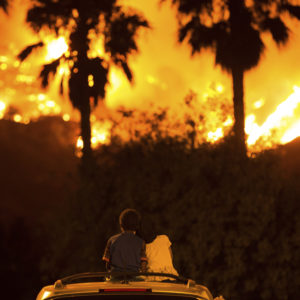California is burning. It was yesterday, it is today, and it will be tomorrow. The price in human life is enormous — in animal and plant life, too. The price in human suffering is gigantic, and the price in property damage is incalculable.
Even while unprecedented high Santa Ana winds are blowing devastation, electric utilities are looking for fixes that accord with the new realities brought about by global warming. Worse is yet to come, they fear.
In January the Edison Electric Institute, a Washington-based trade association, assembled a task force of electric utility CEOs to find solutions. The choices before them are not appealing.
The problem is California may be in the vanguard of fire-prone states, but it is not alone. Many states with heavy forest cover and long electric lines have reason to look to the future with apprehension. What amounts to a perfect fire storm in California could happen in states from Illinois to Louisiana, and from Virginia to Oregon.
Here are the options facing the electric utility CEOs:
—Vegetation control. This is essential, as Rod Kuckro, a reporter for E&E News, points out. But vegetation control — simply cutting down trees near electric lines — is easier said than done. Kuckro, an astute utilities journalist, says that Pacific Gas & Electric Company (PG&E), the utility that has borne the brunt of the blame and whose northern California service area is ground zero for fire, has 125,000 miles of power lines. These are threatened by millions of dead trees, plus the normal threat to power lines from falling trees, dead or alive.
Kuckro says the vegetation issue is complicated by a severe lack of manpower skilled in tree management. Trees must be cut and removed, or they will become fresh fuel for fires.
—Surveillance technology. Long-term technology is going to be decisive. Utilities will need a great deal more real-time data about their lines. Line surveillance, always a utility priority, is becoming job number one, and they are looking to the digital frontier.
Surveillance by men on foot and horse gave way to men and women in helicopters and all-terrain vehicles. Now comes the age of drones and data.
Morgan O’Brien, CEO of Anterix, which offers secure broadband communications to utilities, says with broadband technology and judiciously placed sensors, “a utility control room could know about a falling line in 1.4 seconds.” Time enough to cut off the power and start a repair crew on its way.
But this kind of data solution will take time and, like all the solutions, money. This will be difficult for PG&E, which is already in bankruptcy because of fire claims from last year, and the year before.
—Undergrounding. This sounds so reasonable, so logical. But in most places, it is not an option and not in earthquake-prone California. The cost of burying lines, where they can safely be buried on the PG&E system, is estimated to be as much as $3 million a mile for residential lines to $80 million a mile for high-voltage cables. It would take decades to bury even a few of its lines. And the cost is almost beyond contemplation.
—Microgrids. These are often mentioned. These are autonomous entities usually serving a paper mill, a university, a shopping center or sometimes a whole community. Microgrids self-generate, mostly with gas or solar, and sell surplus power to the utilities; and, in some cases, they act as storage systems for their host utility. Their advantage in a fire-prone region is that they can be isolated from their host grid. Therefore, the lights stay on if the big grid is shut down prophylactically, explains Mike Byrnes, senior vice president of Veolia North America, an energy and environmental services company.
Recently Jacqueline Sargent, general manager of Austin Energy, told me that cybersecurity concerns keep her up at night. For many utility managers that threat is now joined by an existential threat from one of man’s oldest enemies: fire.
If you are the manager of a utility in a blue state, you might also worry whether the federal government will help in a fire disaster. To date, President Trump has let California burn: no federal declaration of a disaster and, accordingly, no federal disaster relief, no troops. Hell, not even a presidential flyover for beleaguered California.
This is not benign neglect. This is vengeful neglect. Remember Puerto Rico?

